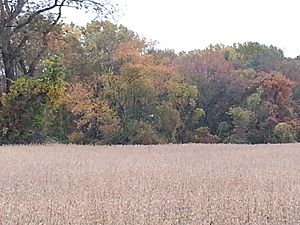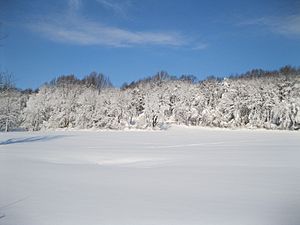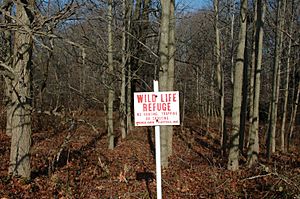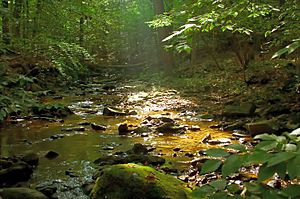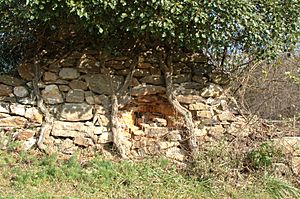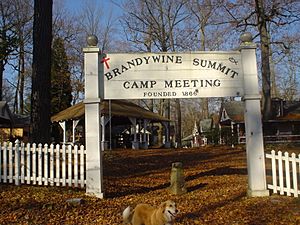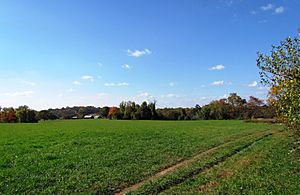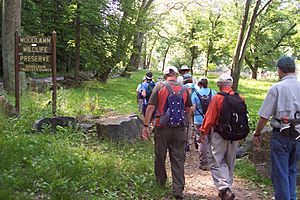Beaver Valley, Delaware and Pennsylvania facts for kids
Quick facts for kids
Beaver Valley, Delaware and Pennsylvania
|
|
|---|---|
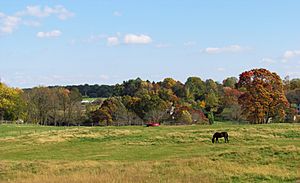
A vista in Beaver Valley, Pennsylvania
|
|
| Country | United States |
| State | Delaware and Pennsylvania |
| County | New Castle and Delaware |
| Township | Chadds Ford and Concord |
| Elevation | 203 ft (62 m) |
| Time zone | UTC-5 (Eastern (EST)) |
| • Summer (DST) | UTC-4 (EDT) |
| Area codes | 302, 484, 610 |
| GNIS feature ID | 216027 |
Beaver Valley is a special place that sits right on the border between Pennsylvania and Delaware. It used to be called Chandler's Hollow. It's not a city or town with its own government, but rather an "unincorporated community." This means it's a place where people live, but it's managed by the larger counties and townships around it.
Many small streams flow through Beaver Valley. These streams eventually join Beaver Run, which then flows into the Brandywine River. The valley is surrounded by important landmarks. To the east is US Route 202, and to the west is the Brandywine River. Thompsons Bridge Road is to the south, and Smithbridge Road is to the north. Beaver Valley Road winds through a large part of the valley.
For many years, most of the land in Beaver Valley has been owned by The Woodlawn Trustees. In the 1970s, they decided to make their lands in Beaver Valley a wildlife refuge. This helped protect the natural beauty and animals there. In 2012, there were plans to build homes and a large store in the valley. These plans would have been very close to the First State National Historical Park.
Contents
Exploring Beaver Valley's Location
Beaver Valley is split almost in half by the state line. About half of it is in southeastern Pennsylvania, within Concord and Chadds Ford Townships. The other half is in northern Delaware, in an area called The Brandywine Hundred.
The historic Brandywine River forms the western edge of Beaver Valley. On its eastern side is Route 202, one of the busiest roads in Pennsylvania and Delaware. A big part of Beaver Valley is now included in the First State National Historical Park. This park was created by President Obama in 2013. It's Delaware's only park that is part of the National Park Service.
Across the Brandywine River to the west is Granogue, a large estate. Other lands that used to belong to the du Pont family are now part of Brandywine Creek State Park. This park is next to Beaver Valley on its southern side.
Did you know Delaware has only one known cave? It's right in Beaver Valley! This cave is about 200 feet west of where Beaver Valley Road and Beaver Dam Road meet. National Geographic magazine even featured the Brandywine Valley and Beaver Valley in 2013, highlighting their historical importance.
A historian named John Thomas Scharf described Beaver Valley a long time ago. He said it was a small village where Beaver Run crossed into Pennsylvania. He also mentioned that it was known as Chandler's Hollow because it was in a deep valley. Early businesses included a store in 1835 and later a shoe factory.
Understanding Beaver Valley's Rocks and Land
Beaver Valley is part of the Piedmont plateau. This is a region of gently rolling hills located between the flat Atlantic Coastal Plain and the tall Appalachian Mountains. The Piedmont in Pennsylvania has three main parts, and Beaver Valley is in the "upland" section. This area has some of the oldest rocks found in Pennsylvania.
These rocks have a very long and complicated history. They were changed a lot by heat and pressure when a supercontinent called Rodinia was forming. This process created many different minerals. For example, you can find significant deposits of mica in the National Historical Park. Early settlers even dug for mica here to use in windows!
The main type of bedrock in Beaver Valley is called the Mt. Cuba Wissahickon Formation. This rock is a mix of different types, including gneiss and schist. Over time, these rocks broke down to form the soil. This soil is very fertile, meaning it's great for growing crops. Local farmers still use some of the land in Beaver Valley to grow hay.
Delaware's Only Known Cave
For a long time, people thought Delaware was the only state without a cave. But in 1958, a local person named George Jackson officially added the Beaver Valley Cave to the national cave records. This cave was studied in the 1940s by the Archeological Society of Delaware. They found clear evidence that Native Americans, specifically the Delaware Indians, used it for shelter and storage.
The cave is small, only about 56 feet deep, and sits very close to the Pennsylvania border. Despite its size, it's one of the most studied caves in the United States. It has been called by many names over the years, including Indian Cave, Beaver Valley Rock Shelter, and Wolf Rock Cave. Today, it's most commonly known as "Beaver Valley Cave."
Wildlife and Nature in Beaver Valley
Beaver Valley is surrounded by busy areas, but its forests feel like a step back in time. Even though they are still recovering from 200 years of farming and milling, they are starting to look like they did when the Lenni Lenape people lived here.
The forests are mostly made up of deciduous trees, which means they lose their leaves in the fall. You can find native tulip poplar, sycamore, beech, red and white oak, cherry, ash, walnut, and American hornbeam trees. There's even one documented American Chestnut tree! These woods are some of the largest and oldest in southeastern Pennsylvania.
Some parts of the forest are called "interior forest" conditions. This means they are far from roads or open fields. These areas are very important nesting spots for many types of songbirds that migrate long distances. Hundreds of bird species, both migratory and those that live here all year, find a safe home in Beaver Valley. This kind of unspoiled habitat is becoming rare in southeastern Pennsylvania.
Beaver Valley is a vital part of the Brandywine and Delaware River watersheds. A watershed is an area of land where all the water drains into a single river or body of water. At least one of its streams is still cold and clean enough for a small group of native brook trout to live there. These trout are at the very southern edge of their natural range.
In the past, the streams were full of minnows, salamanders, and crawfish. These creatures supported populations of mink, weasels, skunks, and raccoons. Efforts to make Beaver Run even cleaner mean that beavers, the animal the valley is named after, might return.
Many old fields in Beaver Valley are slowly turning back into meadows after being used for farming. However, some large fields are still used by local farmers to grow hay. The forests have likely been cut for wood several times since colonial times, but many trees have been standing for over 100 years. Some individual trees might even be 200 or 300 years old!
A Glimpse into Beaver Valley's Past
Before Europeans settled Beaver Valley, the Lenni Lenape people traveled through it. They would go from their summer camp at the Brandywine River to Naaman's Creek. They often stopped at Beaver Valley Cave for rest, shelter, and to store food and supplies.
According to a local historian, Europeans started settling Beaver Valley in the late 1600s and 1700s. Many of these settlers were Quakers who came with William Penn. They wanted to create peaceful communities. They cleared the land and set up family farms, which were common in the area. These farms grew various products, especially grain, for their own use and to sell.
Farmers would send their goods to Philadelphia, the largest city in Colonial America, and from there to Europe. Large Conestoga Wagons traveled on the "great road" (now Route 202). They would stop at taverns in Beaver Valley for rest.
In 1694, Beaver Valley was mentioned as having "mill lands." In 1712, surveyors laying out Beaver Valley Road passed by "the mill that Chandler is building." Until the 1800s, Beaver Run and its smaller streams powered small mills. These mills made everything from lumber to tin, flax, and paper.
By the late 1800s, Beaver Valley was a busy community with hundreds of people. It had two schools, several mills, and many family farms. However, many of the mills and dams were damaged or destroyed by a big flood in 1843.
You can still see signs of these early European settlements in Beaver Valley today. There are stone and wood-framed houses and farm buildings from the 1700s and 1800s. These include barns, corn cribs, and springhouses, which show the area's unique rural history.
Beaver Valley is less than 2 miles from the famous Brandywine Battlefield. Because the area has remained undeveloped since the 1600s, experts believe it has "high potential" for finding important archaeological items.
Why Beaver Valley is Important
Both New Castle County in Delaware and Delaware County in Pennsylvania recognize how important these lands are. New Castle County has suggested that the roads in Beaver Valley become National Scenic Highways. The Delaware County Planning Commission wants to protect the lands in the valley.
The United States government has also stepped in. They named 1,100 acres in New Castle County and Chadds Ford as part of the First State National Historical Park. Beaver Valley makes up a large part of this park.
In April 2013, National Geographic magazine described the valley beautifully. They said it felt like it existed "at some indeterminate point in time... somewhere between the 18th and the 20th centuries." Beaver Valley still looks much like it did when George Washington's army camped nearby during the American Revolutionary War. There's even an old story that British soldiers, called Redcoats, took supplies from locals as they marched through the Brandywine Valley.
In 1890, Beaver Valley had a population of 250 people. By 1900, it was 241.
The Brandywine Summit Camp Meeting
A piece of Beaver Valley's history is still alive at The Brandywine Summit Camp Meeting on Beaver Valley Road. It was started in 1866, just one year after the American Civil War ended. It's one of the oldest camp meetings in Pennsylvania that is still running.
In the late 1800s and much of the 1900s, it became a popular summer spot for middle-class Methodists from Wilmington, Delaware, to West Chester, Pennsylvania. It's a great example of the American Methodist Camp Meeting Movement. Its design, with small cottages around a central square and a tabernacle (a large open-air building for services), was typical for camp meetings at that time.
The wooded land where the camp meeting is located was once part of the William Johnson farm. The specific thirteen acres of the camp were known as Johnson's Woods. The original Johnson farmhouse still stands on Route 202 today, though it has been updated. It now houses the Brandywine Conference and Visitors Bureau.
Fun Things to Do in Beaver Valley
Beaver Valley has a huge network of dirt paths that wind through open meadows, clean streams, thick forests, and lush valleys. These trails offer many different types of terrain for all sorts of outdoor activities.
You'll often see bikers, hikers, horseback riders, runners, bird watchers, artists, cross-country skiers, and dog walkers enjoying what Beaver Valley has to offer. There are several horse farms in the valley, and riders love using the nearby trails. On any given day, you might see groups of mountain bikers riding together.
Bird watchers frequently visit the valley to see the hundreds of migratory and resident bird species that stop or live in Beaver Valley. On a calm summer evening, artists are drawn to the fields on the east side of the valley. Their beautiful paintings often hang in local restaurants and businesses.
Many hiking clubs and groups regularly schedule hikes in the valley during all seasons. A short walk through part of the valley might take a dog walker half an hour. More serious hikers can explore for several hours through The Woodlawn Wildlife Refuge, Brandywine State Park, and the First State National Historical Park.
On a summer ride or hike down to the river, you might see kayakers or rafters floating down to Thompson's Bridge. Or you might spot groups of cyclists racing along Brandywine Creek Drive. Several cycling and hiking groups help maintain the trails in the wildlife refuge. You can often see them clearing fallen trees with chainsaws.
Merlin Brubaker and Conservation Efforts
Merlin Brubaker was a chemist who worked for DuPont. He lived in Beaver Valley on a 51-acre estate for over 40 years, from the late 1930s to the mid-1980s. Mr. Brubaker wanted to protect his land in Beaver Valley from being developed. He even turned down offers from developers that would have paid him more money.
In the late 1970s, Mr. Brubaker asked Stephen Clark, the president of Woodlawn, if they would buy his estate and protect it. Woodlawn agreed and allowed Mr. Brubaker to continue living on his estate for as long as he wished.
However, in June 2014, there were plans announced to build 171 houses on Dr. Brubaker's former estate. Several groups are working to stop this development and keep Beaver Valley a natural place. These groups include The Beaver Valley Preservation Alliance, Save The Valley, and The Beaver Valley Conservancy.
|





